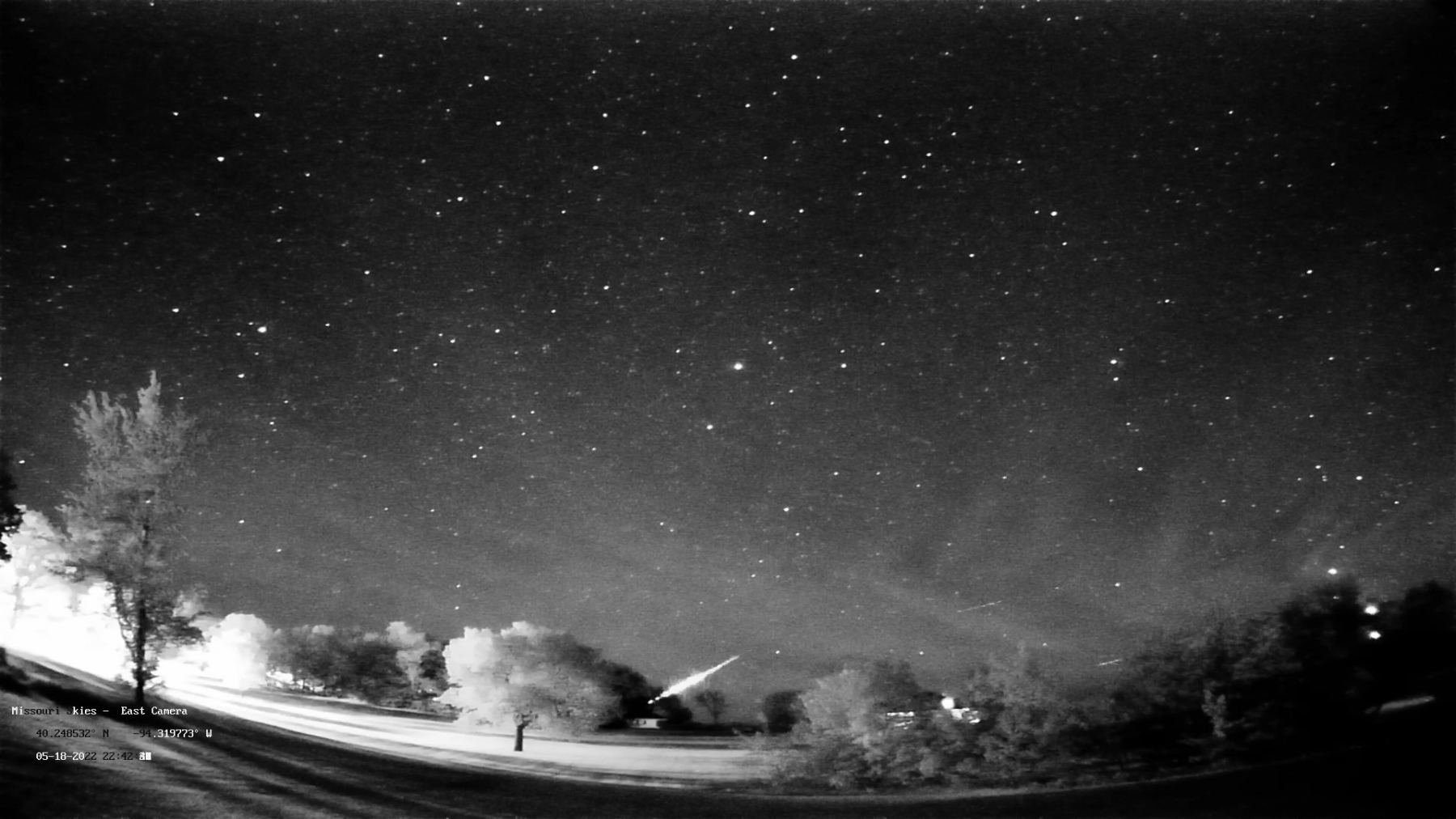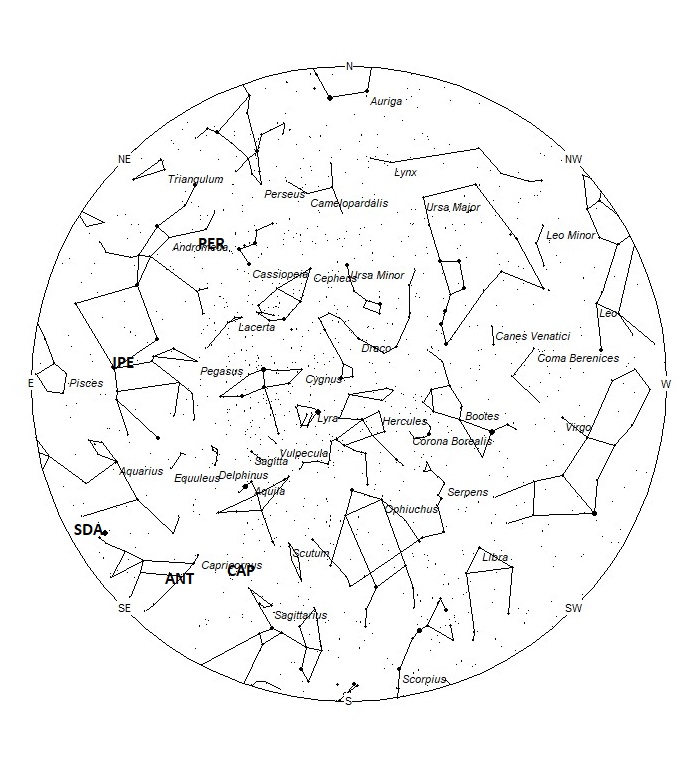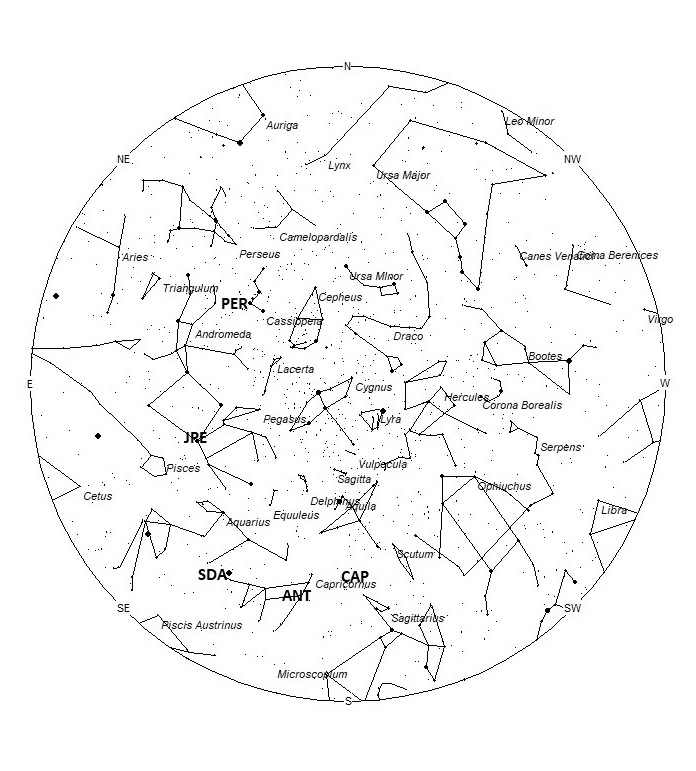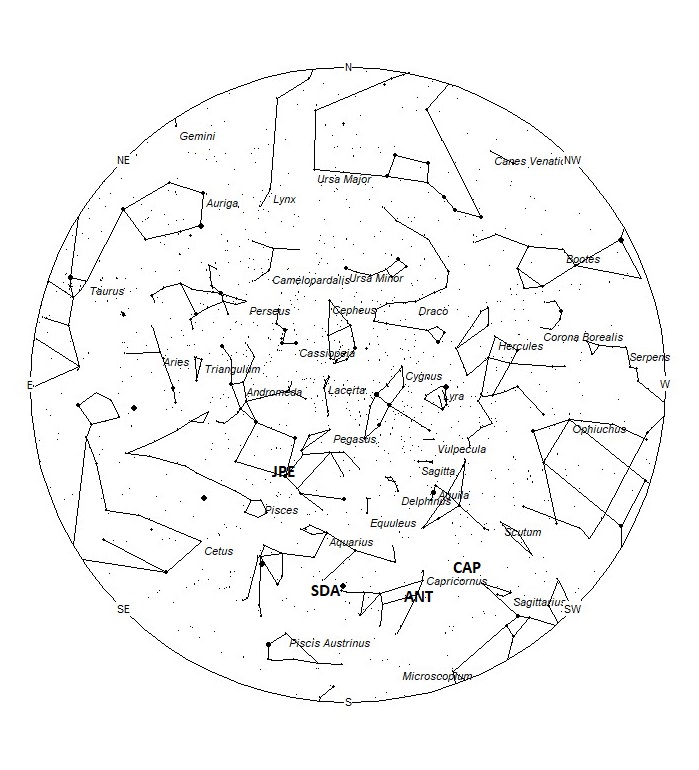 Daniel Bush captured this fireball low in the eastern sky at 03:42 UT (22:42 CDT) on April 19, 2022 (April 18th local date), from Albany, Missouri USA. For more information on this fireball visit: https://fireball.imo.net/members/imo_view/event/2022/2967 ©Daniel Bush
Daniel Bush captured this fireball low in the eastern sky at 03:42 UT (22:42 CDT) on April 19, 2022 (April 18th local date), from Albany, Missouri USA. For more information on this fireball visit: https://fireball.imo.net/members/imo_view/event/2022/2967 ©Daniel BushDuring this period, the moon reaches its last quarter phase on Wednesday July 20th. At that time the moon is located 90 degrees west of the sun and rises near midnight local Summer Time (LST). This weekend the waning gibbous moon will rise during the late evening hours and will bathe the sky in bright moonlight the remainder of the night. Therefore, conditions for viewing meteor activity will be more favorable toward the end of this period. The estimated total hourly rates for evening observers this week should be near 3 as seen from mid-northern latitudes (45N) and 3 as seen from tropical southern locations (25S) For morning observers, the estimated total hourly rates should be near 9 as seen from mid-northern latitudes (45N) and 11 as seen from tropical southern locations (25S). Morning rates are reduced due to interfering moonlight. The actual rates will also depend on factors such as personal light and motion perception, local weather conditions, alertness, and experience in watching meteor activity. Note that the hourly rates listed below are estimates as viewed from dark sky sites away from urban light sources. Observers viewing from urban areas will see less activity as only the brighter meteors will be visible from such locations.
The radiant (the area of the sky where meteors appear to shoot from) positions and rates listed below are exact for Saturday night/Sunday morning July 16/17. These positions do not change greatly day to day so the listed coordinates may be used during this entire period. Most star atlases (available at science stores and planetariums) will provide maps with grid lines of the celestial coordinates so that you may find out exactly where these positions are located in the sky. I have also included charts of the sky that display the radiant positions for evening, midnight, and morning. The center of each chart is the sky directly overhead at the appropriate hour. These charts are oriented for facing south but can be used for any direction by rotating the charts to the desired direction. A planisphere or computer planetarium program is also useful in showing the sky at any time of night on any date of the year. Activity from each radiant is best seen when it is positioned highest in the sky, either due north or south along the meridian, depending on your latitude. It must be remembered that meteor activity is rarely seen at the radiant position. Rather they shoot outwards from the radiant, so it is best to center your field of view so that the radiant lies at the edge and not the center. Viewing there will allow you to easily trace the path of each meteor back to the radiant (if it is a shower member) or in another direction if it is sporadic. Meteor activity is not seen from radiants that are located far below the horizon. The positions below are listed in a west to east manner in order of right ascension (celestial longitude). The positions listed first are located further west therefore are accessible earlier in the night while those listed further down the list rise later in the night.
These sources of meteoric activity are expected to be active this week.
.
The alpha Capricornids (CAP) are active from July 7 through August 15, peaking on July 31st. The radiant is currently located at 19:44 (296) -13. This position lies in northwestern Sagittarius, 7 degrees west of the naked eye double star known as (alpha Capricornii). Current rates are expected to be near 1 per hour as seen from the Northern Hemisphere and 2 per hour as seen from south of the equator. These meteors are best seen near 01:00 local Summer Time (LST), when the radiant lies highest in the sky. With an entry velocity of 23 km/sec., the average meteor from this source would be of slow velocity.
The large Anthelion (ANT) is currently centered at 20:28 (307) -19. This position lies in western Capricornus, near the faint star known as pi Capricorni. This radiant is best placed near 02:00 LST when it lies on the meridian and is highest in the sky. Rates at this time should be near 1 per hour as seen from the Northern Hemisphere and 2 as seen from south of the equator. With an entry velocity of 30 km/sec., the average Anthelion meteor would be of slow velocity.
The Southern delta Aquariids (SDA) are now active from a radiant located at 22:04 (331) -18. This area of the sky is located in southwestern Aquarius, 4 degrees south of the 4th magnitude star known as iota Aquarii A. This location is also just a few degrees southeast of the first magnitude planet Saturn. This radiant is best placed near 0400 LST, when it lies on the meridian and is located highest in the sky. Hourly rates at this time should be less than 1 as seen from the Northern Hemisphere and near 1 as seen from south of the equator. With an entry velocity of 41 km/sec., the average meteor from this source would be of medium velocity.
The July Pegasids (JPE) are active from July 4th through August 8th with maximum activity occurring on July 11th. The radiant is currently located at 23:08 (347) +16. This area of the sky is located in southern Pegasus, 1 degree north of the 2nd magnitude star known as Markab (alpha Pegasi). This radiant is best placed near 0400 LST, when it lies on the meridian and is located highest in the sky. Rates are expected to be less than 1 per hour this week no matter your location. With an entry velocity of 61 km/sec., the average meteor from this source would be of swift velocity.
The first Perseids (PER) of the year should be sighted mid-week from a radiant located at 00:32 (008) +51. This position is not in Perseus, rather it lies in southern Cassiopeia, 3 degrees southwest of the 4th magnitude star known as zeta Cassiopeiae. This area of the sky is best placed for viewing during the last dark hour before dawn when it lies highest in the sky. Maximum is not until August 13th so current rates are expected to be less than 1 no matter your location. With an entry velocity of 59 km/sec., the average meteor from this source would be of swift velocity.
As seen from the mid-northern hemisphere (45N) one would expect to see approximately 7 sporadic meteors per hour during the last hour before dawn as seen from rural observing sites. Evening rates would be near 2 per hour. As seen from the tropical southern latitudes (25S), morning rates would be near 7 per hour as seen from rural observing sites and 2 per hour during the evening hours. Locations between these two extremes would see activity between the listed figures. Morning rates are reduced by moonlight.
The list below offers the information from above in tabular form. Rates and positions are exact for Saturday night/Sunday morning except where noted in the shower descriptions.
| SHOWER | DATE OF MAXIMUM ACTIVITY | CELESTIAL POSITION | ENTRY VELOCITY | CULMINATION | HOURLY RATE | CLASS |
| RA (RA in Deg.) DEC | Km/Sec | Local Summer Time | North-South | |||
| alpha Capricornids (CAP) | Jul 30 | 19:44 (296) -13 | 23 | 01:00 | 1 -2 | II |
| Anthelion (ANT) | – | 20:28 (307) -19 | 30 | 02:00 | 1 – 2 | II |
| Southern delta Aquariids (SDA) | Jul 30 | 22:04 (331) -18 | 41 | 04:00 | <1 – 1 | I |
| July Pegasids (JPE) | Jul 10 | 23:08 (347) +16 | 61 | 05:00 | <1 – <1 | II |
| Perseids (PER) | Aug 13 | 00:32 (008) +51 | 59 | 06:00 | <1 – <1 | I |







 You saw something bright and fast? Like a huge shooting star? Report it: it may be a fireball.
You saw something bright and fast? Like a huge shooting star? Report it: it may be a fireball.  You counted meteors last night? Share your results with us!
You counted meteors last night? Share your results with us!  You took a photo of a meteor or fireball? You have a screenshot of your cam? Share it with us!
You took a photo of a meteor or fireball? You have a screenshot of your cam? Share it with us!  You caught a meteor or fireball on video? Share your video with us!
You caught a meteor or fireball on video? Share your video with us!